
By Daniel P. Sheridan
In 1986, the South Bronx was still reeling from the firestorm that tore through the borough in the 1960s and 1970s. The area resembled many of the bombed-out cities in Europe after World War II. We were still routinely going to fires in these vacant buildings (photos 1 and 2). Young firefighters like me saw these calls as opportunities to learn the job better.
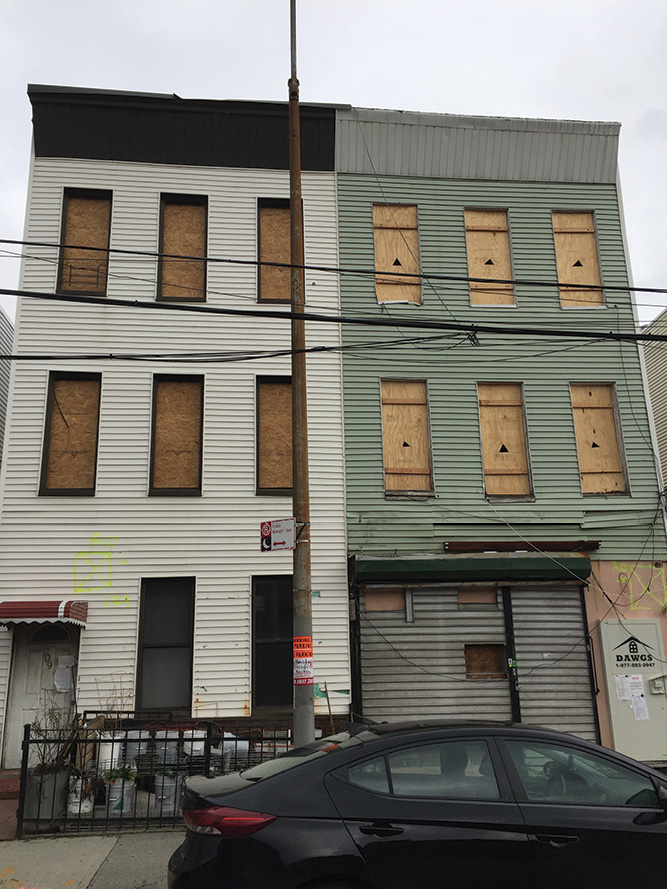
(1) Two vacant adjacent row-frame houses/buildings. The structure on the right has HUD windows and door and window guard systems (DAWGS). (Photos by author.)
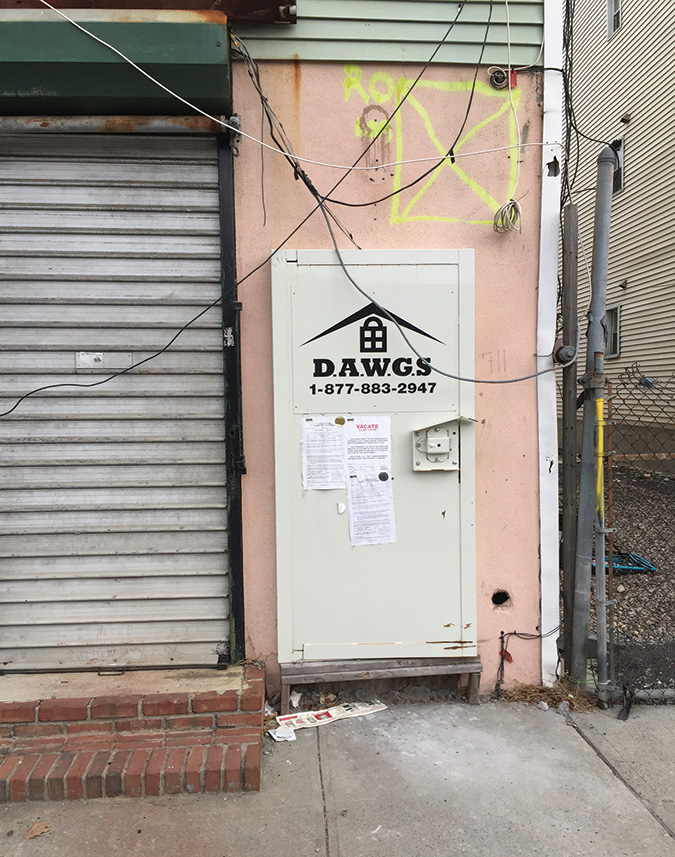
(2) The door system and vacant building marking. On both buildings, the marking of “X” inside a box with the letters “RO” means roof open, no entry, exterior operations only, marked by Ladder 29. For a building in bad disrepair, we would search depending on the fire condition. If there is heavy fire, we would wait until it is under control and search from areas of safety.
Today, I have a whole different perspective; all I see when I look at these buildings now are the potential problems. When I was a young firefighter, I learned about forcible entry, ventilation, search, and many other aspects of firefighting. But in today’s fire service, we need to find a balance between effective firefighter training opportunities and safety.
Below are the issues to consider before opting for an aggressive interior attack.
Structural Stability
What do you know about the building? How long has the building been vacant? What is its construction type (photos 3-5)? Fire resistive (Type 1) construction is the most stable; the stability of ordinary construction (Type 3) depends on the structure’s condition; and wood-frame (Type 5) is the least stable.
Consider the structure’s condition: Have previous fires weakened the structure? Has vandalism weakened the building? Look for holes in the floors created to remove costly building materials and in the bathrooms for removed piping. Is the building sealed and marked or is it open to the elements?
Known Life Hazard
Assume that a life hazard is present until proven otherwise. In many of the vacant buildings to which I responded over the years, drug dealers were using them to sell their goods or homeless people were squatting.

(3) A typical one-story vacant wood-frame (Type 5) private dwelling with a possible life hazard.

(4) A two-story ordinary construction (Type 3) vacant dwelling with a possible life hazard.
Possible life hazard indications include the following: lights, curtains, window shades, plants, and window guards in the windows; signs of forcible entry and holes in the walls for ingress or egress; extension cords running from street utility poles or adjoining buildings; and information from neighbors.
At a recent fire, the neighbors reported trapped occupants. There was an entry hole in the side window and extension cords ran up the back of the building, but the reports turned out to be unfounded. In a subsequent fire occurring the week after, two victims were found in an upper bedroom; they apparently died from an overdose of heroin (photo 6).
Fire Size and Location
The amount of fire you encounter on arrival plays a key part in deciding how to attack the fire. You attack a heavy fire condition in a Type 5 structure differently than you would attack the same amount of fire in a Type 1 or 3 structure. In years past, the chiefs didn’t like tying up numerous units for a vacant building fire for long periods. They were willing to be a bit more aggressive (within reason) regardless of the amount of fire found.
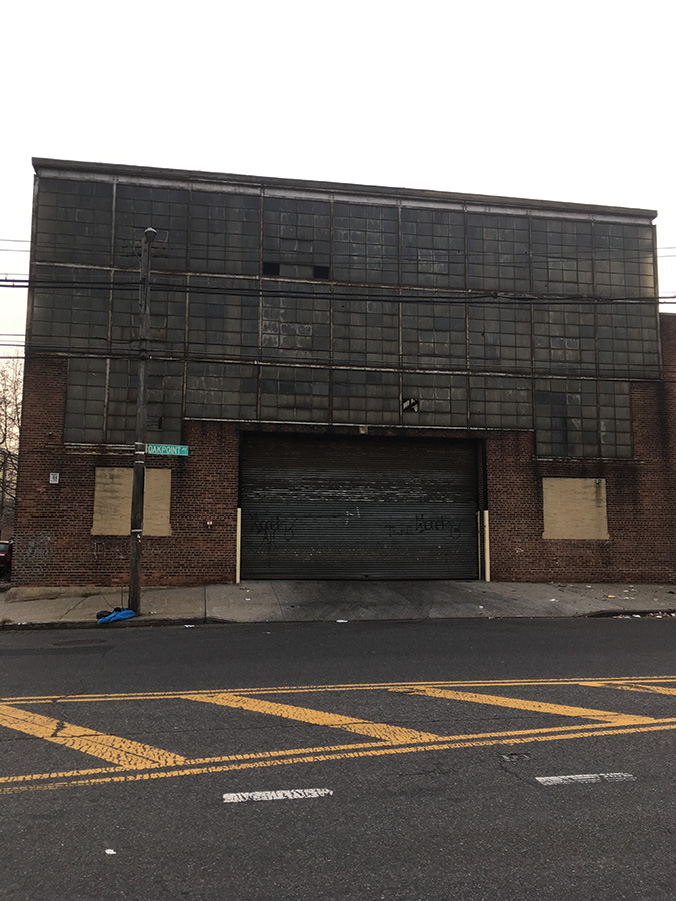
(5) At this vacant commercial dwelling, life hazard is not likely, although squatters are always a possibility.
A fire on an upper floor, especially a top-floor fire, raises a safety factor. Firefighters have been killed by falling ceilings or by falling through floors. Before deciding to aggressively attack a fire on an upper floor, ensure that there are at least two means of egress. Ladder the whole fire building (photo 7).
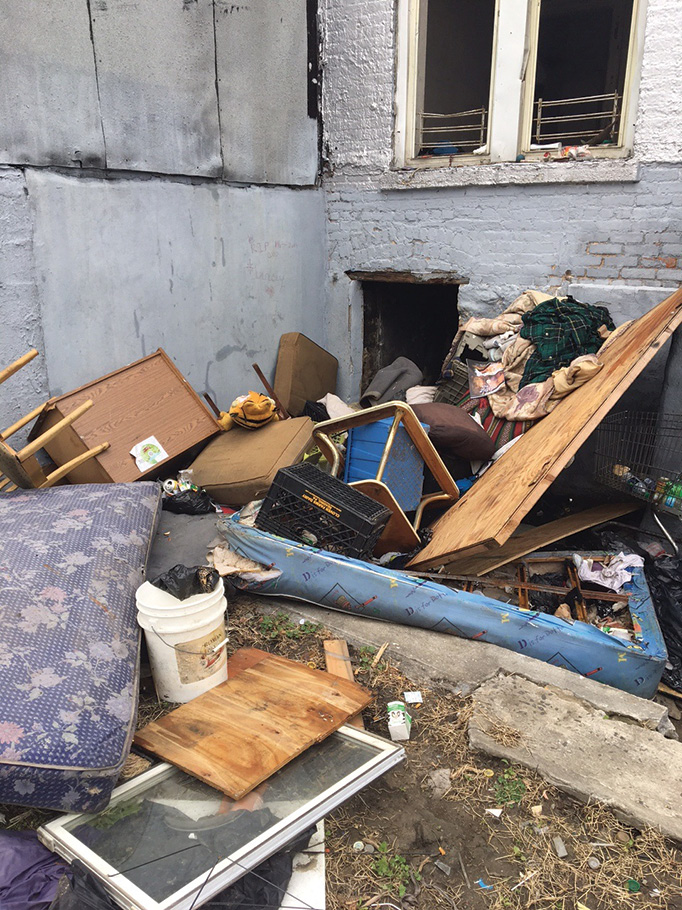
(6) A vacant building with access in the rear.
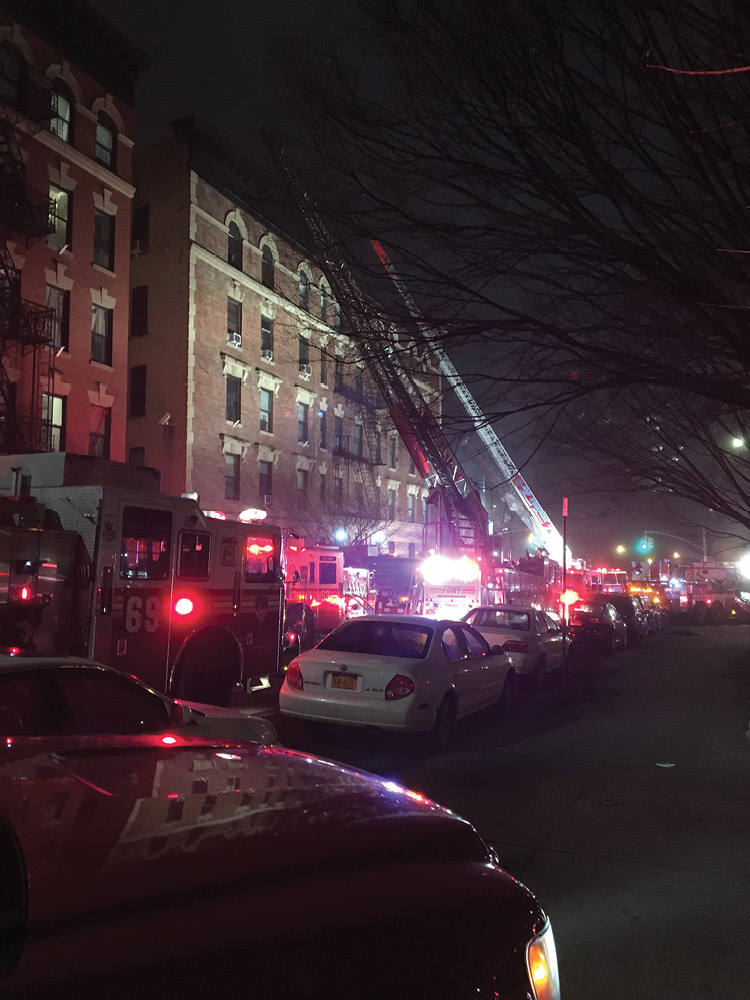
(7) A properly laddered building.
Verify Safe Access
Because of the heavy clutter encountered, recognize that you may be putting firefighters in a situation where their means of egress would be impeded. Their access should be unobstructed. Previous fires in these buildings will have weakened the floor joists. Send firefighters to the floor below to check for weakened structural members and holes in the floor.
Exposures
Life safety is always first. Knowing the type of construction is also a factor in deciding on how to attack a fire. A fire in a structure of Type 1 or Type 3 construction would generally be confined to the building of origin. Although a fire wall that runs through the roof between two buildings will stop the spread of fire, smoke could be an issue.
When I was a lieutenant, we responded to a fire in a vacant brownstone with heavy fire on two floors. After considering all factors, we decided on an aggressive interior attack. En route, we received a report that people were trapped in the B side exposure. The building had a heavy smoke condition, and an elderly woman was trapped in her apartment. I guided her to safety while the engine stretched a 1¾-inch hoseline with a 15⁄16-inch smooth bore nozzle.
Type 5 buildings are entirely different. Fire will extend into the exposures through the common cockloft or by radiant heat. The fire will spread with lightning speed once it enters the cockloft. It is important to get ahead of the fire, even if it means skipping a building. If ladder companies are not available, engine companies should bring a six-foot hook. Be careful not to open up too much of the ceiling until you have water in the hoseline and are ready to operate (photo 8).
Number/Type of Responding Units
The initial assignment should include a tower ladder or an aerial device capable of producing a master stream. Leave room in front of the building for a master stream. Water delivery may also be an issue. If your department runs only tankers, consider a tanker shuttle operation. Position a supply engine next to a portable tank, and ensure access and egress for shuttle tankers. Designate one officer as a water supply officer. If possible, put those units on a separate tactical channel. If your department has access to hydrants, you will require a dedicated engine company for a large-caliber stream.
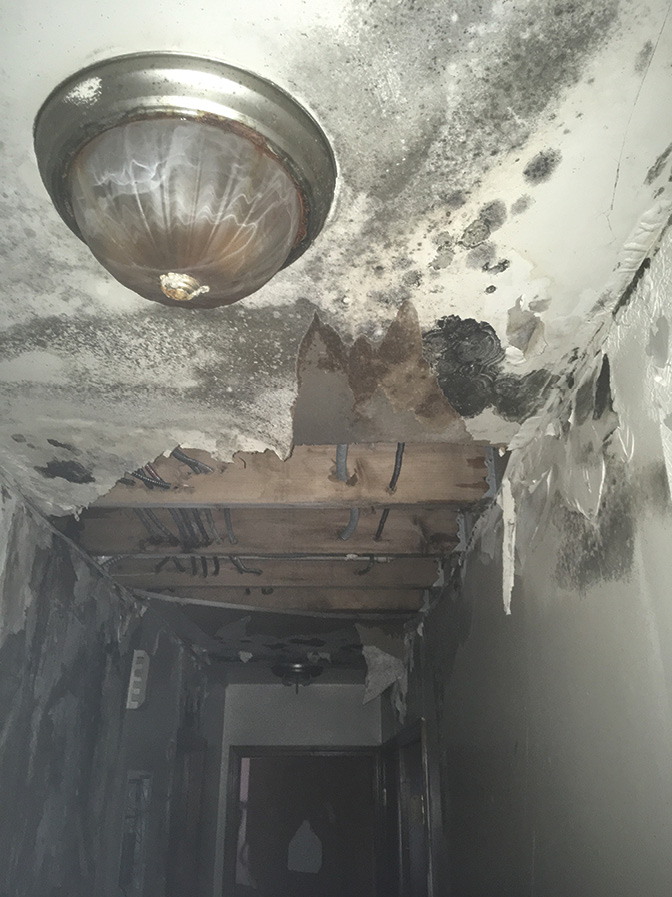
(8) Take care when opening ceilings. Have a hoseline in place before opening too much.
You will need units for exposures as well. Depending on the building construction, you will need additional alarms to check on exposures. Use the incident command system (ICS) to manage the span of control. In the ICS, divisions are geographic, groups are functional. The Fire Department of New York (FDNY) uses sector and numbers. For example, “Fire sector,” “Exposure 2 sector.” Designate officers to head the divisions/groups. This will make communications and managing the areas easier: Bravo division, Delta division, Fire division, Roof division, Water Resource group, and Rapid Intervention Team group.

(9) A HUD window close up. Use the point of the halligan to split the wood or use a saw to cut the bolts.
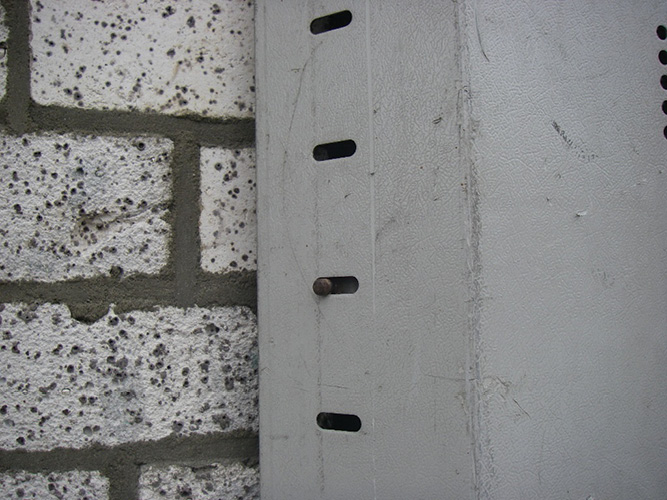
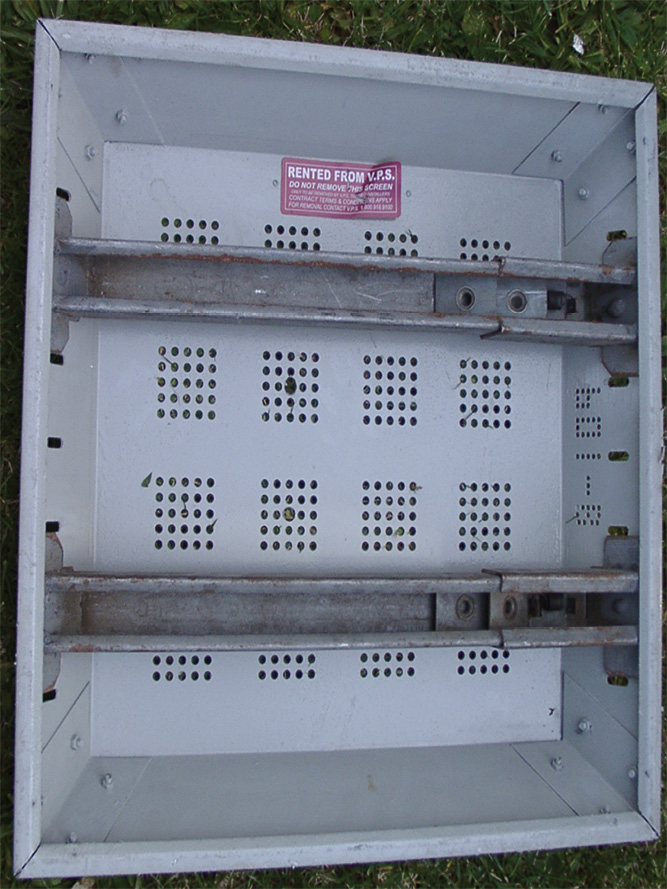
(10-11) A spring-loaded vacant property system (VPS).
Forcible Entry
Buildings that are sealed with vacant property systems (VPS) or Housing and Urban Development (HUD) windows will present serious delays in getting that vital first hoseline stretched and operating. One HUD window method uses a combination of 2 × 4s and plywood. A sheet of plywood is placed over the window opening and is secured with two 2 × 4s. Each 2 × 4 uses two bolts that go through the window opening to secure the plywood. There are a few ways to force them (photo 9).
Plywood HUD windows. Strike both of the 2 × 4s with the pike end of the halligan and split the wood. You may also use a chain saw to cut the 2 × 4s. This will release the tension on the bolt and allow the 2 × 4 enough slack to release the plywood.
Alternatively, use the forcible entry saw with the aluminum oxide blade to cut the bolt heads. Once the bolt head is cut, use the pike head of the halligan to knock in the bolt. Do this from a tower ladder basket.
Metal HUD windows. Using the ax or the fork/back end of the halligan, strike the middle of the metal. The metal will crumple toward the middle and cause the nails to pull out. You can then use the fork end of the halligan to force the rest of the window.
VPS. VPS look a lot more formidable than they are. They are very easy to force from inside with any tool.
VPS secured with spring-loaded crossbars with side pins. The two bars are under tension between the two window jambs (photos 10-11). Using a power saw with a metal-cutting blade, make a cut perpendicular to the crossbar. Cut both bars, which will release tension (photos 12). Or, using an ax and the pike end of a halligan, drive the point of the halligan into the metal and make a hole above or below the pin and pull out the metal (photo 13). Alternatively, using an ax and the adz end of a halligan, insert the adz between the wall and metal and pull out the pin.
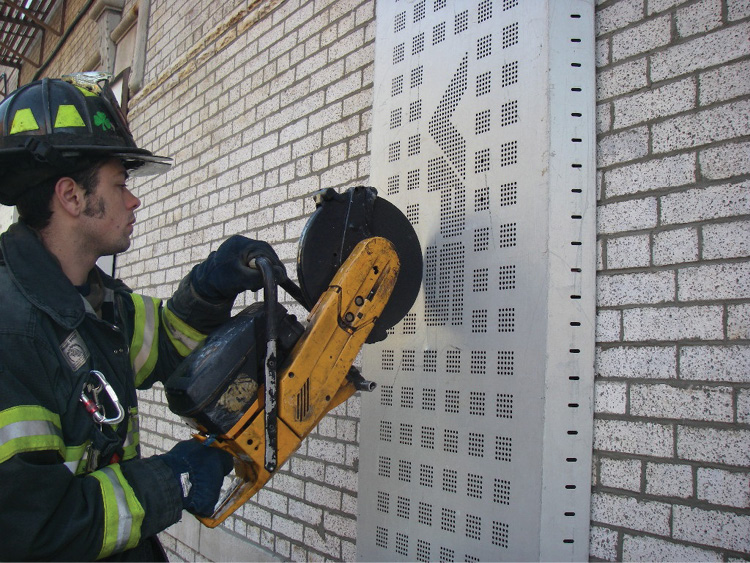
(12) This firefighter is cutting the VPS bars inside the window guard.
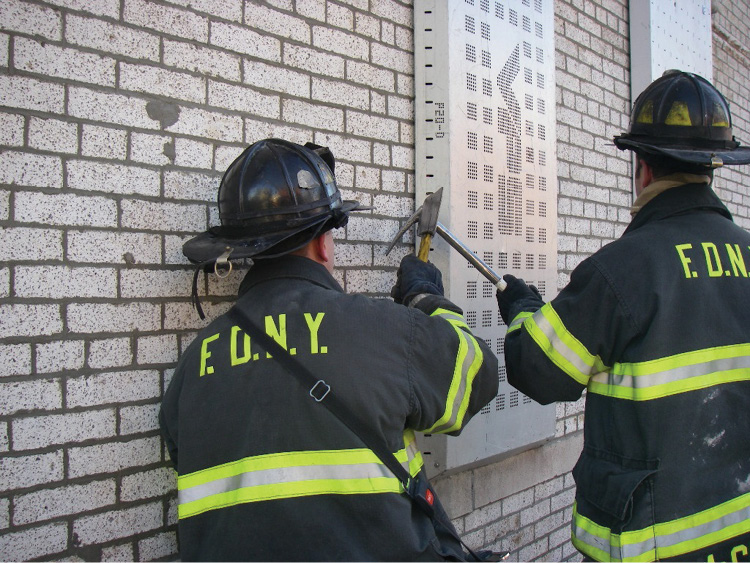
(13) Firefighters are using forcible entry tools to pry the window covering off.

(14) A cable-type VPS, outside view.
VPS secured with cables or threaded rods. The outside bolts are connected by a cable or a threaded rod to a crossbar inside the window (photos 14-15). Using a power saw with a metal-cutting blade, make a cut on the head of the cable, and repeat for all four cables (photos 16). Or, using an ax and a halligan, use the adz end of the halligan to shear the heads of the cables, and repeat with all four cables (photo 17).
Doors. Conventional methods will not work. Cut a hole in the door, and reach in and slide the lever.
Engine Company Operations
The building will dictate what size of hoseline to stretch. For a fire in a vacant taxpayer or a commercial building, regardless of the amount of fire, stretch a 2½-inch hoseline with a 11/8-inch nozzle. The 2½-inch hoseline is more powerful, but it is heavy and difficult to maneuver. Follow the DALUS memory aid if in any doubt as to which hoseline to deploy. DALUS: Purely Defensive, Advanced fire on arrival, Large volume of fire, Uncompartmented area, Size undetermined.
We responded to a fire in a vacant row-frame once and were ordered to stretch a hoseline to protect the exposure. We stretched a 2½-inch hoseline, started intermittently hitting the fire, and cooled down the exposure. Once we made a good knockdown of the fire, we needed to bring the hoseline into the fire building for final extinguishment. The building had narrow and tight hallways, and the line became impossible to move. A 1¾-inch line would have been a better choice once it became apparent that we needed to make entry. In hindsight, it would have been a good idea to add a length of 1¾-inch line to the 2½-inch.
When we used to respond to numerous vacant building fires in larger multiple dwellings, the interior stairs were often found in disrepair and very unsafe. Consider using a rope to stretch hose for fires on upper floors. Engine companies used a bleach bottle containing 75 feet of rope to deploy the rope from the floor below and stretch the hose up to the fire floor (photo 18).
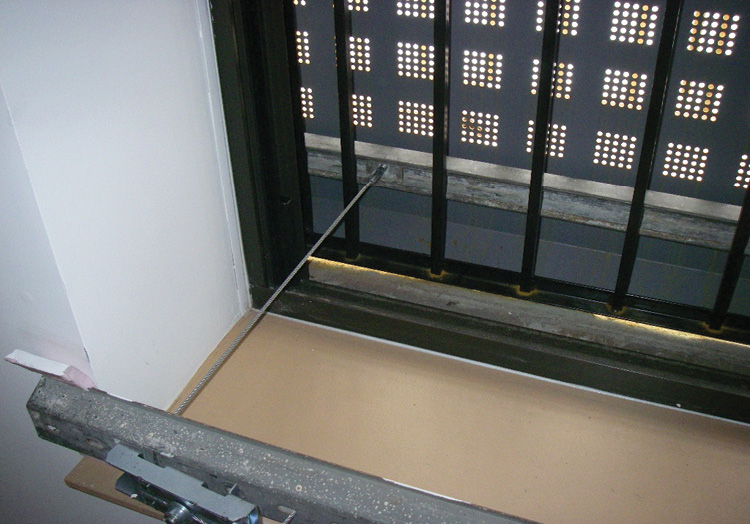
(15) A cable-type VPS, inside view.
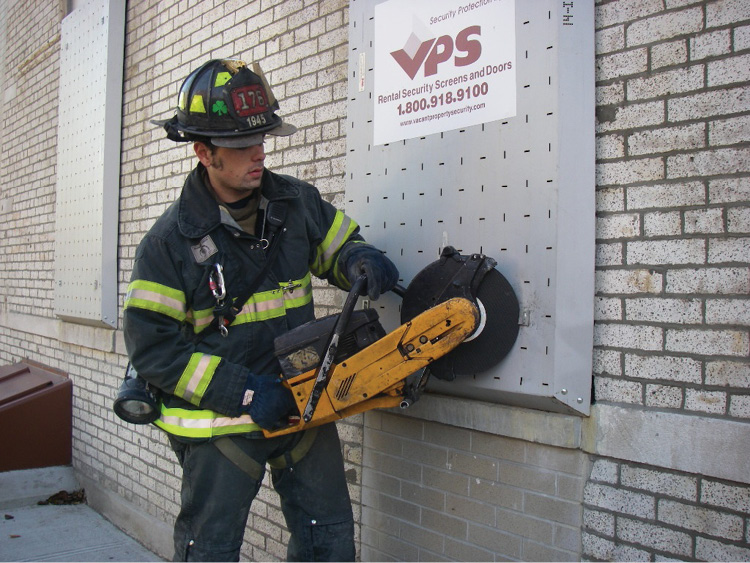
(16) A firefighter uses a saw to cut the bolt head on a cable-type VPS window guard.
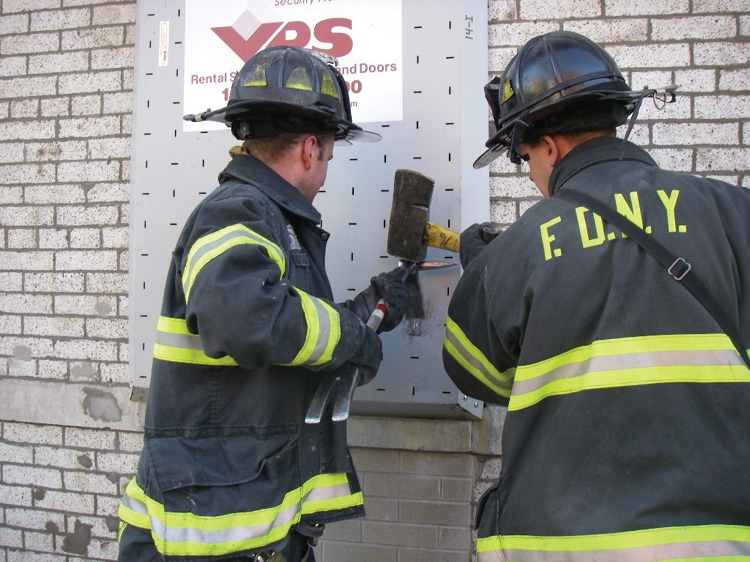
(17) Firefighters use forcible entry tools to shear the bolt head on a VPS window guard.
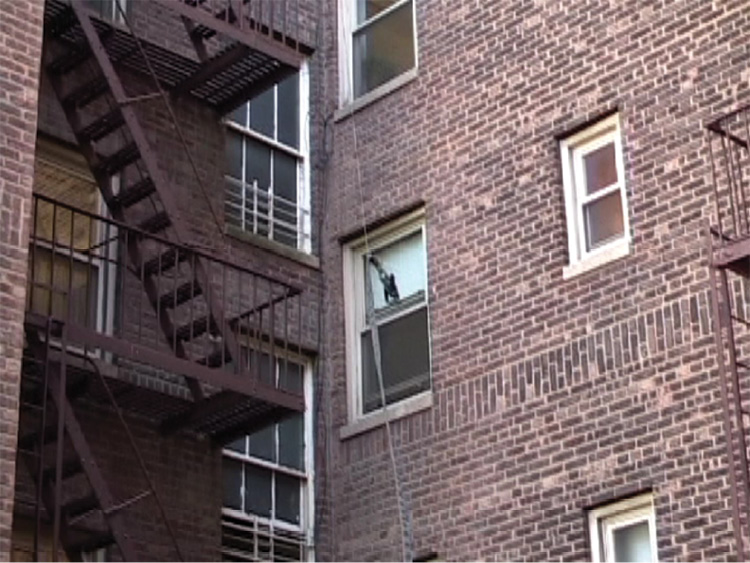
(18) A bleach bottle or a bag containing rope can be used for stretching hoselines on the outside of the building when the condition of the interior stairs is questionable.
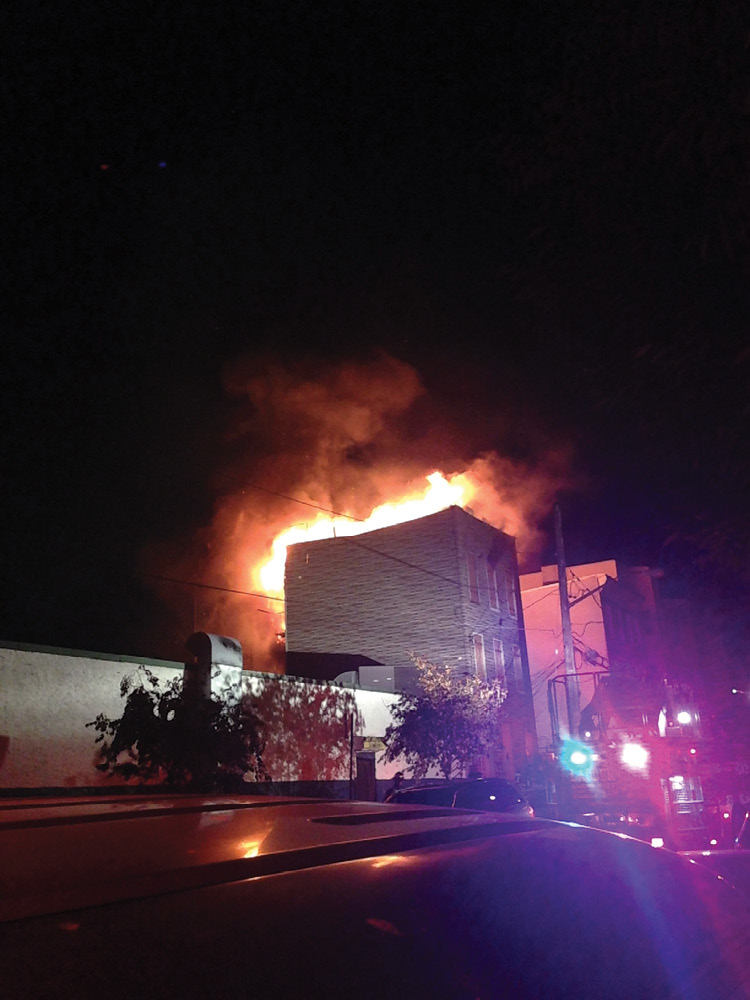
(19) An exterior attack was employed at this fire in a vacant wood-frame structure.
Caution: If you are responding to a fire in a vacant building and arson is suspected, use EXTREME CAUTION. Arsonists will use gasoline on an upper floor because it ignites more quickly. They would then use diesel on a lower floor. Engine companies going above could become trapped on an upper floor if a fire breaks out below them. A fire claimed the life of an FDNY firefighter when he was caught on the upper floor by a fire that was set below.
Defensive Operations
If you have the least bit of doubt after you have considered all the pertinent points and feel that a defensive operation is warranted, prepare for a large-caliber stream. The tower ladder is a versatile weapon; it is flexible and can cover a lot of area. If the fire building is heavily involved on a few floors, the stream should start at the lower levels and work upward. Preventing fire spread to the upper floors and the cockloft is extremely important.
Tower ladders can be used aggressively. They are not just a tool for pouring water on the building for the next few hours. Get up close to the window and drive the stream up into the ceiling. Use the stream to break down the walls and penetrate the stream into the seat of the fire.
If the building is in danger of collapse, set up a collapse zone that is at least the height of the building. For a Type 1 or Type 3 building, collapse is not as much of a problem as it may be with a type 5 structure. In a Type 3 building, the parapet is the biggest collapse concern; if the parapet seems unsteady, keep the bucket away from it.
Do not use tower ladder streams to shoot water over rooftops. Roofs are designed to keep water out of the building; you are giving up the building if you use this tactic.
Get the stream up into the cockloft, and move the nozzle around. In smaller buildings, you can use a deck gun in the same way.
Case Study
When I was a firefighter working in a tower ladder unit, we responded to a fire in a vacant row-frame building. The building on the B side was already torn down. Essentially, row frames are like Sequoia trees: They hold each other up. When one building or both buildings are missing, the buildings are severely compromised. It was the last night for one of the senior engine firefighters. We were ready for an interior attack. It would be the last time he would ever have the nozzle.
The chief wanted nothing to do with that; he was vehemently opposed to our going anywhere near the inside of that building. He ordered us to set up the tower ladder and commence an exterior attack. We were not happy: What did that old chief know? Reluctantly, I set up the bucket with the chauffeur and began to extinguish the fire. We knocked down the fire in about a half hour. We shut down the stream and began to work on removing the cornice to look for hot spots. Suddenly, the bucket moved—or so I thought. I asked my partner why he moved the bucket. He gave me a puzzled look and told me that the building just collapsed.
Thirty years later, I am working in my battalion and receive a call for a fire in a three-story vacant row-frame building. I knew the building, which had been vacant for a long time and had suffered numerous fires. I read the response ticket information, which indicated that there were numerous voids and holes in the building. I immediately informed the dispatcher that under no circumstances should any firefighters enter the building until I arrived on scene. When I arrived on scene, I called for an additional tower ladder and we employed a defensive operation (photo 19).
That old chief is still around. I would see him sometimes at different FDNY functions. One time, he was with his son, a lieutenant. He said to me, “Hey, Dan, tell my son about that fire where I kept you guys out.” He was proud of that call, and he should be; he definitely saved a few firefighters’ lives that day.
Vacant buildings are dangerous. Usually, the risk is not worth the reward. However, vacant doesn’t mean unoccupied. You still need to check on the life hazard. Second, if the building is sound, it is a great opportunity for young firefighters to get some valuable experience. Maintain high supervision; don’t get too aggressive, and things should work out. If you have any doubt, set up the master streams.
DANIEL P. SHERIDAN is a 32-year veteran of the Fire Department of New York, where he is a battalion chief. He has worked in Harlem and the Bronx for most of his career. He is a national instructor and the founder and chief operating officer of Mutual Aid Training Group.

